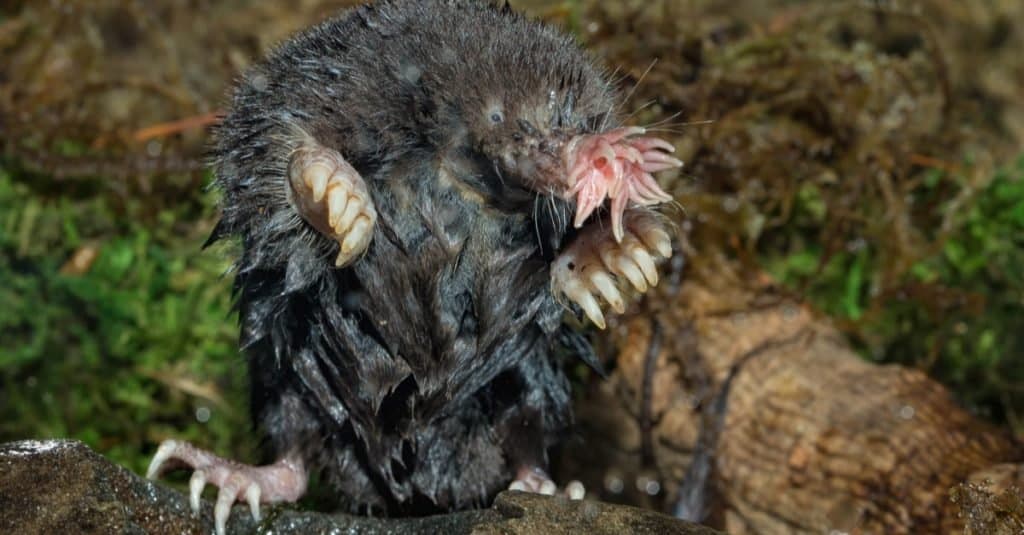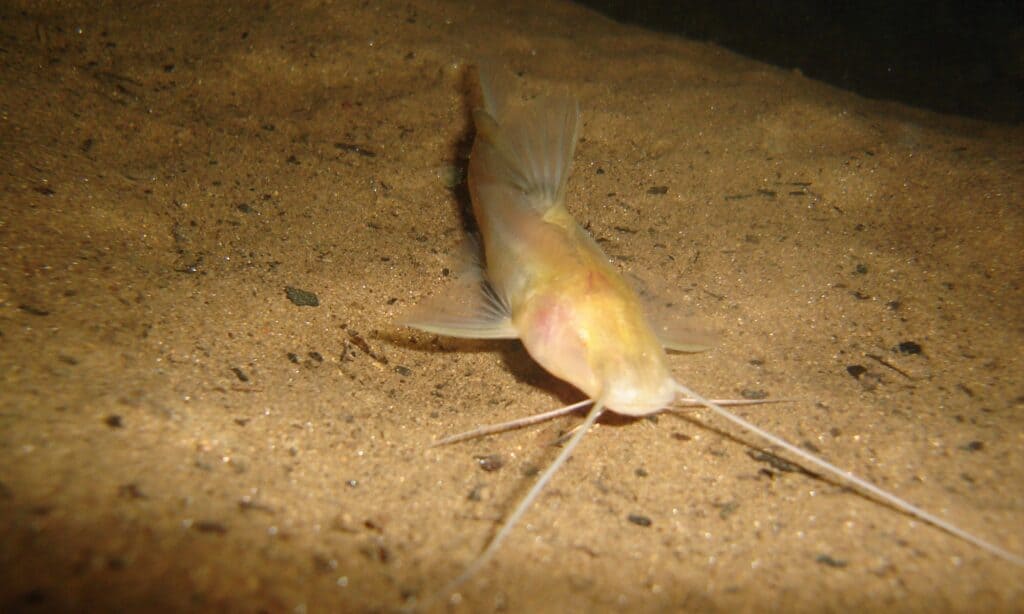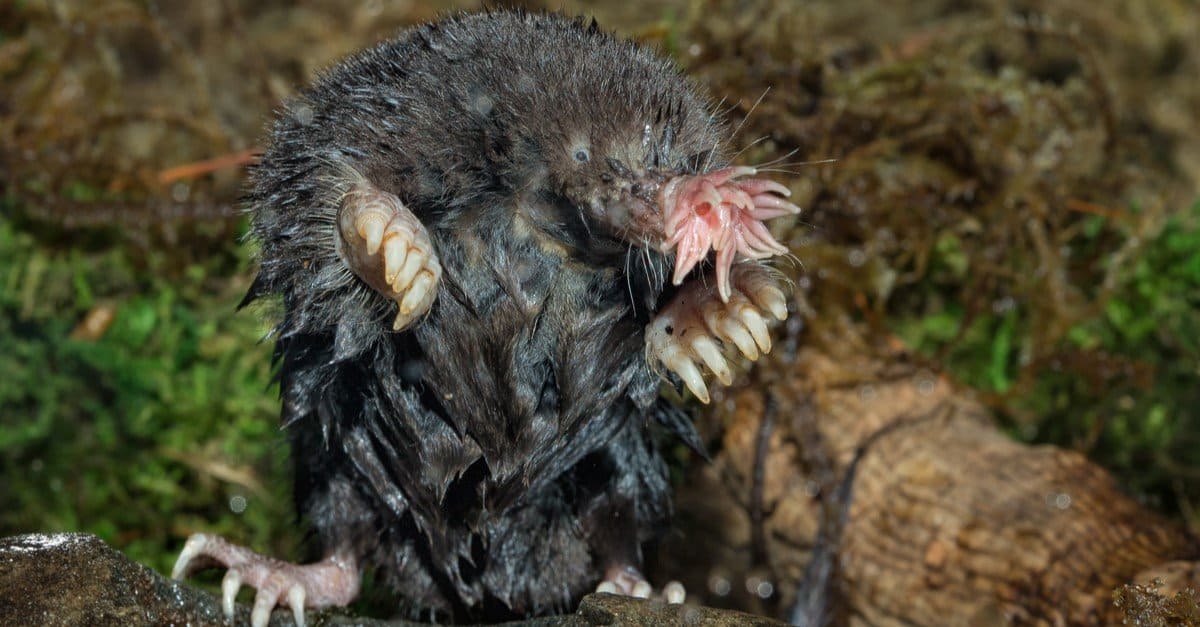It should be known that not every animal has eyes. About 96% of the animal kingdom has optical systems used for seeing. There is, however, a small percentage of animals who appear to have eyes but are blind, and an even smaller number who have no “eyes” at all! This article will discuss 5 exceedingly unusual animals that are completely sightless or lack eyes! Here’s a preview:

So, get ready to learn some other interesting abilities these creatures possess, despite the lack of a sense of sight.
1. Texas Blind Salamander

The Texas blind
salamander
senses changes in water pressure.
©Matt Jeppson/Shutterstock.com
An amphibian known as the Texas blind salamander can survive in complete darkness. Seeing isn’t required, so it bears two black patches on its skin instead of eyes. It is translucent white or pink due to the lack of light. Bright crimson gills protrude from the throat area. These gills are present at birth because the creature is well-adapted to an aquatic and subterranean existence. Its legs are slender and lengthy to help it sustain its weight. The Texas blind salamander grows to a length of 3 to 5 inches. A sizable portion of its body is made up of its finned tail.
Location
Very few of these salamanders exist in the United States. For their survival, they rely on a continual supply of cool, pure water from an aquifer in Hays County, Texas, known as the Edwards Aquifer. Hence the name “Texas” blind salamander.
Diet
It’s the Texas blind salamanders who prey on everything else in their remote habitat. However, snails and shrimp are the salamander’s primary prey. Slight changes in water pressure allow it to detect prey by sensing their motions through the subtle changes.
2. Star–Nosed Mole

Star-nosed moles are blind and rely on sensory organs to feel their way around.
©Agnieszka Bacal/Shutterstock.com
The star-nosed mole is an incredibly unique animal. The tip of its “snout,” which gives it its name, has 11 pairs of pink tentacles spread out like a star. It is the only member of its tribe with “Eimer’s organs,” which are touch organs, with more than 25,000 tiny sensory receptors. These receptors help it feel its way around. Therefore, it has no need for eyes!
The star-shaped nose also lets the mole smell underwater, which was thought to be impossible for mammals. This suggests that the star-nosed mole is extreme in the evolution of mammals. In fact, it may have the most sensitive sensory system of any mammal on earth!
Location
The star-nosed mole lives in the eastern part of North America, which includes the United States and southeastern Canada. It can also be found from the Atlantic coast south to Georgia and all the way through the Appalachians.
Star-nosed moles live in many places with moist soil, such as woods, bogs, marshes, fields, and even cities. They are often found near water and at higher altitudes.
Diet
Star-nosed moles are good swimmers and have been spotted swimming beneath the icy surface of the Arctic. Insects and aquatic life are therefore major food sources for this species. Earthworms and water insects are its principal diet, but it also eats crayfish, snails, tiny amphibians, and fish.
3. Freshwater Hydra

The fact that hydras don’t appear to age at all is one of the many fascinating facts about them.
©Rattiya Thongdumhyu/Shutterstock.com
Hydra is a genus of freshwater Cnidarians. It has tentacles like its saltwater counterparts. Hydra features a tubular body, a “head,” and a “foot.” However, it lacks eyes, a brain, and muscles. Instead, it relies on its “nerve nets.” These nets connect its body wall photoreceptors and tentacle touch receptors. Hydra uses these tentacles to sense and capture its prey.
Biologists are fascinated by Hydras’ regenerating abilities as they don’t appear to age. That’s right; hydra stem cells self-renew, indefinitely. Hydras can regenerate damaged tissue and can even reproduce by budding a new head when damaged!
Location
Hydras can be found in both temperate and tropical areas. Various freshwater ecosystems are home to Hydras. They are mostly found in ponds, lakes, and slow-moving sections of streams and rivers. Sessile in nature, hydras cling to submerged vegetation, wood, or stones for their entire existence.
Diet
As predatory creatures, hydras feed on a wide variety of invertebrates, including worms and bug larvae. They also eat small crustaceans and fish larvae. They entangle their prey in their tentacles and kill them with their stinging cells before they devour them!
4. Widemouth Blindcat

The widemouth blindcat has no eyes and can only be found in Mexico and Texas waters.
©iStock.com/juniorpetar
In North America, you’ll find the widemouth blindcat, a species of catfish with no eyes! It’s completely white or pink in color and can only be found in Mexico’s aquifers and on the Edwards Plateau in Texas.
It has thick lips at the corner of its mouth, which give it its name. The lower jaw has folds that separate the two membranes which cover the gills. This creature has a big and flat nose and a wide and flat head. The widemouth blindcat typically grows no bigger than 5.25 inches in overall length.
Location
The San Antonio Pool of the Edwards Aquifer in Bexar County, Texas, is known to be a frequent habitat for the widemouth blindcat. It can be found in water as deep as 1862 feet beneath the surface!
Diet
The widemouth blindcat predominantly eats fish, insects, and crustaceans as well as other invertebrates and reptiles. It is an opportunistic feeder, so it also eats other small catfish and pretty much anything else that moves or vibrates.
5. Kaua’i Cave Wolf Spider

Kaua’i cave wolf spiders are found only in the caves of Kaua’i and have evolved to have no eyes.
©Gordon Smith / This image or recording is the work of a U.S. Fish and Wildlife Service employee, taken or made as part of that person’s official duties. As a work of the U.S. federal government, the image is in the public domain. For more information, see the Fish and Wildlife Service copyright policy. – Original / License
The Kauai cave wolf spider is a small hunting spider that has adapted to survive in lava tubes! This is the only wolf spider species to have evolved to have no eyes. Instead, it relies on chemical and vibrational cues to locate its prey in the environment. It ranges from 0.50 to 0.75 inches in size.
Location
The Kauai cave wolf spider needs a high humidity environment to avoid dying from moisture loss. It has only been found in the deepest part of Koloa Cave in the Hawaiian Islands. It can only be found in the most remote and difficult-to-reach areas of caves.
Diet
The Kauai cave wolf spider is an opportunistic eater, meaning it feeds whenever feasible on other cave occupants. The Kauai cave amphipod and invasive spiders and cockroaches are a typical part of its diet.
Summary of 5 Animals without Eyes
| Name of Blind Animal | Substitute for Eyes | Location |
|---|---|---|
| Texas Blind Salamander | Slight changes in water pressure | Edwards Aquifer in Texas |
| Star-Nosed Mole | Touch organs with sensory receptors | North America |
| Freshwater Hydra | Nerve nets and tentacles | Temperate and Tropical Zones |
| Widemouth Blindcat | Taste, smell, heat, flow, and touch | Edwards Aquifer in Texas and Mexico |
| Kaua’i Wolf Spider | Chemical and vibrational clues | Koloa Cave in Hawaii |
Conclusion
How surprising is it to learn that these species are thriving even though they lack eyes? It’s fascinating to learn how they have evolved and successfully adapted to their environments. These eyeless animals have adapted to live in a habitat where they do not require the use of their eyes and are thriving!
Thank you for reading! Have some feedback for us? Contact the AZ Animals editorial team.








